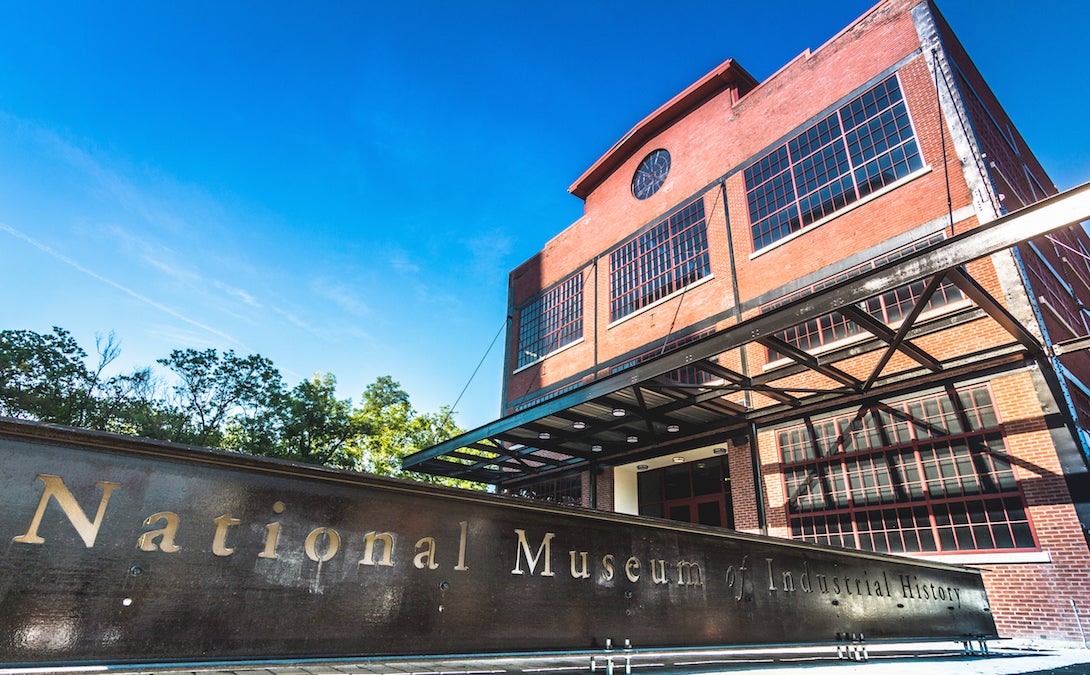National Museum of Industrial History opens in Bethlehem

After 19 years
A former Bethlehem Steel mill has been converted into a Smithsonian affiliate.
Visitors to the new National Museum of Industrial History, open today in Bethlehem, will be engaging with history before they even set foot inside the museum. It’s built on the nation’s largest privately-owned brownfield site, in what was Bethlehem Steel’s electric repair shop.
The museum documents America’s transition from agrarian to industrial. Visitors will learn about all facets of industrialization, from the rise of the steel mills and textile industry to labor movements and protests. Much of that history has its roots in Pennsylvania, which is why the state draws a lot of the focus in the initial exhibits.
“Every global story has a local element and if we want people to connect, there has to be a person, an invention that started in a local place,” said executive director Amy Hollander. “And then, how did that local story become a global one?”
The museum is interactive: there are scavenger hunts and audio recordings to listen in on. See how much horsepower you can generate with a hand-cranked flywheel train engine, or try holding a 20 pound tray of bobbins from the silk mill. (Don’t get too cocky. Child laborers used to carry those trays for nine hours a day.)
The NMIH was the first museum to be named a Smithsonian affiliate, meaning it will host exhibits from the Smithsonian collection on loan. While the museum was being developed, others have become affiliates as well.
Currently, a popular Smithsonian exhibit about the 1876 World’s Fair in Philadelphia is on show. Hollander says this was the first time America stepped onto the world’s stage as something other than an agrarian society.
“It changed the perception of the country,” she said. “We have a quote from the Times of London painted on the wall in the museum, where they said, ‘The American invents as the Greeks sculpted and the Italians painted. It’s genius.'”
Creating a museum of industry in the Rust Belt seems to make sense. Here, more than elsewhere in the country, it often feels like industry is a relic of the past, ready to be memorialized in a museum. But Hollander says they are well aware that America still runs on industry.
“We have a gallery that is going to be called Industry 4.0,” she said. “It’s going to look at the continuing evolution and development of industry, because it’s not a finished story. And we are partnering with local schools and universities to help young people connect the developments of the past with innovations of the future.”
19 years and counting
Nearly twenty years ago, the NMIH was proposed as a parting gift from Bethlehem Steel. The company offered an $80 million investment to reconfigure three old steel mills into a massive industrial museum.
But, the Allentown Morning Call reports,
Bethlehem Steel, which had been shepherding the museum, slid into bankruptcy and ultimately sold the shuttered plant. The museum’s opening date was repeatedly pushed back as organizers tried to raise more money to finish the job.
Plans were revamped and donors continued to contribute just enough to keep the project alive. But behind the scenes, officials privately questioned the viability of a museum. By 2005, another project had captured the imagination of the community eager to transform the idle plant into a tourist destination: the Las Vegas Sands Corp.
Today, the SteelStacks development is a centerpiece of downtown Bethlehem. In addition to the Sands Casino, there are art galleries, performance spaces and a public television station. And the final piece: the museum that was originally intended to anchor the space.
Raising enough money to open the museum without corporate support, during a recession, was an uphill battle. But the museum faced some internal challenges as well. According to a grand jury hearing two years ago, the museum’s leadership did nothing explicitly criminal, but they wasted nearly $18 million through poor management.
That ruling resulted in the firing of museum CEO Stephen Donches. The office of the Attorney General advised the non-profit organization to open the museum within two years or dissolve any plans to go forward.
The grand opening, under Hollander and a new management team, is the result of that ultimatum.
Adding to the industrial legacy
Pennsylvania has a number of state museums that document our industrial heritage — the Lumber Museum, the Anthracite Heritage Museum, the Maritime Museum. Rusty Baker, director of PA Museums, a trade organization, hopes the NMIH will unite those narratives.
“It’s the sort of thing where one big museum can raise all boats,” where the boats are smaller museums across the state. “To have the national museum of industry here in Pennsylvania, and to have it be a Smithsonian affiliate, will only bring more attention to Pennsylvania’s industrial heritage and our museums.”
His association has found that a third of museumgoers in Pennsylvania say they are interested in learning more about the state’s heritage. Based on those numbers, he thinks the new museum will be a big success.
The museum’s grand opening weekend coincides with Muzikfest, Bethlehem’s biggest tourist draw. Even those not compelled by Pennsylvania history and heritage might find it hard to say no to air conditioning and scavenger hunts.
WHYY is your source for fact-based, in-depth journalism and information. As a nonprofit organization, we rely on financial support from readers like you. Please give today.


